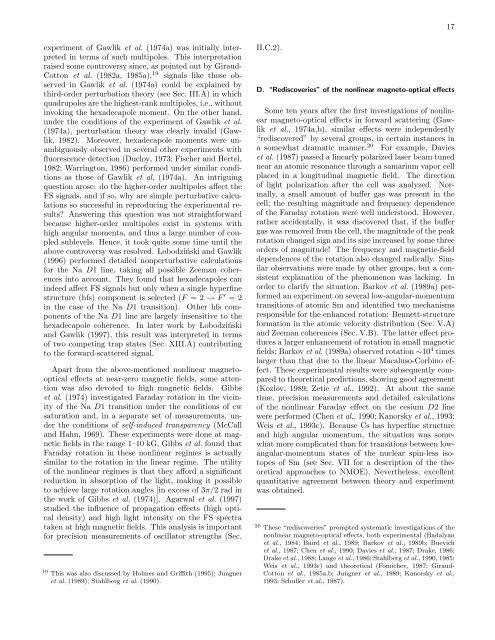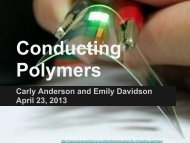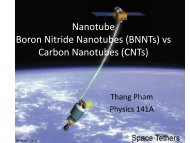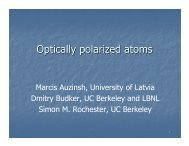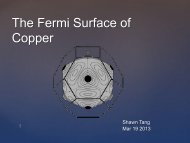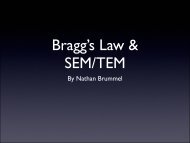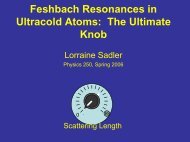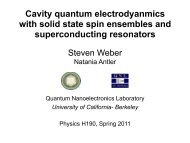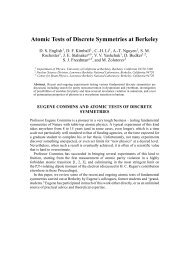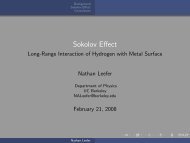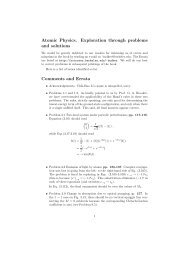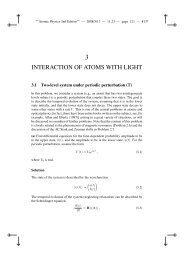Resonant nonlinear magneto-optical effects in atomsâ - The Budker ...
Resonant nonlinear magneto-optical effects in atomsâ - The Budker ...
Resonant nonlinear magneto-optical effects in atomsâ - The Budker ...
You also want an ePaper? Increase the reach of your titles
YUMPU automatically turns print PDFs into web optimized ePapers that Google loves.
17<br />
experiment of Gawlik et al. (1974a) was <strong>in</strong>itially <strong>in</strong>terpreted<br />
<strong>in</strong> terms of such multipoles. This <strong>in</strong>terpretation<br />
raised some controversy s<strong>in</strong>ce, as po<strong>in</strong>ted out by Giraud-<br />
Cotton et al. (1982a, 1985a), 19 signals like those observed<br />
<strong>in</strong> Gawlik et al. (1974a) could be expla<strong>in</strong>ed by<br />
third-order perturbation theory (see Sec. III.A) <strong>in</strong> which<br />
quadrupoles are the highest-rank multipoles, i.e., without<br />
<strong>in</strong>vok<strong>in</strong>g the hexadecapole moment. On the other hand,<br />
under the conditions of the experiment of Gawlik et al.<br />
(1974a), perturbation theory was clearly <strong>in</strong>valid (Gawlik,<br />
1982). Moreover, hexadecapole moments were unambiguously<br />
observed <strong>in</strong> several other experiments with<br />
fluorescence detection (Ducloy, 1973; Fischer and Hertel,<br />
1982; Warr<strong>in</strong>gton, 1986) performed under similar conditions<br />
as those of Gawlik et al. (1974a). An <strong>in</strong>trigu<strong>in</strong>g<br />
question arose: do the higher-order multipoles affect the<br />
FS signals, and if so, why are simple perturbative calculations<br />
so successful <strong>in</strong> reproduc<strong>in</strong>g the experimental results<br />
Answer<strong>in</strong>g this question was not straightforward<br />
because higher-order multipoles exist <strong>in</strong> systems with<br />
high angular momenta, and thus a large number of coupled<br />
sublevels. Hence, it took quite some time until the<br />
above controversy was resolved. ̷Lobodziński and Gawlik<br />
(1996) performed detailed nonperturbative calculations<br />
for the Na D1 l<strong>in</strong>e, tak<strong>in</strong>g all possible Zeeman coherences<br />
<strong>in</strong>to account. <strong>The</strong>y found that hexadecapoles can<br />
<strong>in</strong>deed affect FS signals but only when a s<strong>in</strong>gle hyperf<strong>in</strong>e<br />
structure (hfs) component is selected (F = 2 → F ′ = 2<br />
<strong>in</strong> the case of the Na D1 transition). Other hfs components<br />
of the Na D1 l<strong>in</strong>e are largely <strong>in</strong>sensitive to the<br />
hexadecapole coherence. In later work by ̷Lobodziński<br />
and Gawlik (1997), this result was <strong>in</strong>terpreted <strong>in</strong> terms<br />
of two compet<strong>in</strong>g trap states (Sec. XIII.A) contribut<strong>in</strong>g<br />
to the forward-scattered signal.<br />
Apart from the above-mentioned <strong>nonl<strong>in</strong>ear</strong> <strong>magneto</strong><strong>optical</strong><br />
<strong>effects</strong> at near-zero magnetic fields, some attention<br />
was also devoted to high magnetic fields. Gibbs<br />
et al. (1974) <strong>in</strong>vestigated Faraday rotation <strong>in</strong> the vic<strong>in</strong>ity<br />
of the Na D1 transition under the conditions of cw<br />
saturation and, <strong>in</strong> a separate set of measurements, under<br />
the conditions of self-<strong>in</strong>duced transparency (McCall<br />
and Hahn, 1969). <strong>The</strong>se experiments were done at magnetic<br />
fields <strong>in</strong> the range 1–10 kG. Gibbs et al. found that<br />
Faraday rotation <strong>in</strong> these <strong>nonl<strong>in</strong>ear</strong> regimes is actually<br />
similar to the rotation <strong>in</strong> the l<strong>in</strong>ear regime. <strong>The</strong> utility<br />
of the <strong>nonl<strong>in</strong>ear</strong> regimes is that they afford a significant<br />
reduction <strong>in</strong> absorption of the light, mak<strong>in</strong>g it possible<br />
to achieve large rotation angles [<strong>in</strong> excess of 3π/2 rad <strong>in</strong><br />
the work of Gibbs et al. (1974)]. Agarwal et al. (1997)<br />
studied the <strong>in</strong>fluence of propagation <strong>effects</strong> (high <strong>optical</strong><br />
density) and high light <strong>in</strong>tensity on the FS spectra<br />
taken at high magnetic fields. This analysis is important<br />
for precision measurements of oscillator strengths (Sec.<br />
19 This was also discussed by Holmes and Griffith (1995); Jungner<br />
et al. (1989); Stahlberg et al. (1990).<br />
II.C.2).<br />
D. “Rediscoveries” of the <strong>nonl<strong>in</strong>ear</strong> <strong>magneto</strong>-<strong>optical</strong> <strong>effects</strong><br />
Some ten years after the first <strong>in</strong>vestigations of <strong>nonl<strong>in</strong>ear</strong><br />
<strong>magneto</strong>-<strong>optical</strong> <strong>effects</strong> <strong>in</strong> forward scatter<strong>in</strong>g (Gawlik<br />
et al., 1974a,b), similar <strong>effects</strong> were <strong>in</strong>dependently<br />
“rediscovered” by several groups, <strong>in</strong> certa<strong>in</strong> <strong>in</strong>stances <strong>in</strong><br />
a somewhat dramatic manner. 20 For example, Davies<br />
et al. (1987) passed a l<strong>in</strong>early polarized laser beam tuned<br />
near an atomic resonance through a samarium vapor cell<br />
placed <strong>in</strong> a longitud<strong>in</strong>al magnetic field. <strong>The</strong> direction<br />
of light polarization after the cell was analyzed. Normally,<br />
a small amount of buffer gas was present <strong>in</strong> the<br />
cell; the result<strong>in</strong>g magnitude and frequency dependence<br />
of the Faraday rotation were well understood. However,<br />
rather accidentally, it was discovered that, if the buffer<br />
gas was removed from the cell, the magnitude of the peak<br />
rotation changed sign and its size <strong>in</strong>creased by some three<br />
orders of magnitude! <strong>The</strong> frequency and magnetic-field<br />
dependences of the rotation also changed radically. Similar<br />
observations were made by other groups, but a consistent<br />
explanation of the phenomenon was lack<strong>in</strong>g. In<br />
order to clarify the situation, Barkov et al. (1989a) performed<br />
an experiment on several low-angular-momentum<br />
transitions of atomic Sm and identified two mechanisms<br />
responsible for the enhanced rotation: Bennett-structure<br />
formation <strong>in</strong> the atomic velocity distribution (Sec. V.A)<br />
and Zeeman coherences (Sec. V.B). <strong>The</strong> latter effect produces<br />
a larger enhancement of rotation <strong>in</strong> small magnetic<br />
fields; Barkov et al. (1989a) observed rotation ∼10 4 times<br />
larger than that due to the l<strong>in</strong>ear Macaluso-Corb<strong>in</strong>o effect.<br />
<strong>The</strong>se experimental results were subsequently compared<br />
to theoretical predictions, show<strong>in</strong>g good agreement<br />
(Kozlov, 1989; Zetie et al., 1992). At about the same<br />
time, precision measurements and detailed calculations<br />
of the <strong>nonl<strong>in</strong>ear</strong> Faraday effect on the cesium D2 l<strong>in</strong>e<br />
were performed (Chen et al., 1990; Kanorsky et al., 1993;<br />
Weis et al., 1993c). Because Cs has hyperf<strong>in</strong>e structure<br />
and high angular momentum, the situation was somewhat<br />
more complicated than for transitions between lowangular-momentum<br />
states of the nuclear sp<strong>in</strong>-less isotopes<br />
of Sm (see Sec. VII for a description of the theoretical<br />
approaches to NMOE). Nevertheless, excellent<br />
quantitative agreement between theory and experiment<br />
was obta<strong>in</strong>ed.<br />
20 <strong>The</strong>se “rediscoveries” prompted systematic <strong>in</strong>vestigations of the<br />
<strong>nonl<strong>in</strong>ear</strong> <strong>magneto</strong>-<strong>optical</strong> <strong>effects</strong>, both experimental (Badalyan<br />
et al., 1984; Baird et al., 1989; Barkov et al., 1989b; Buevich<br />
et al., 1987; Chen et al., 1990; Davies et al., 1987; Drake, 1986;<br />
Drake et al., 1988; Lange et al., 1986; Stahlberg et al., 1990, 1985;<br />
Weis et al., 1993c) and theoretical (Fomichev, 1987; Giraud-<br />
Cotton et al., 1985a,b; Jungner et al., 1989; Kanorsky et al.,<br />
1993; Schuller et al., 1987).


